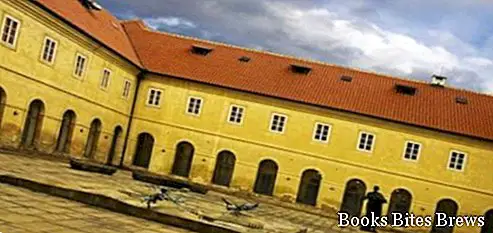In the monastery of San Giorgio, adjacent to the basilica of the same name, there are important collections of works related to ancient Bohemian art.
Visit of the Monastery of San Giorgio
It is a Benedictine building dating back to the year 973, which has been destroyed more than once and promptly rebuilt and transformed.
The baroque reconversion took place in the second half of the seventeenth century, while the monastery was abandoned by its religious functions in the second half of the eighteenth century.
It was in the years between 1962 and 1974 that it was restructured to adapt it to the new task of hosting relevant art collections.
The collections, displayed in chronological order, begin with Gothic works, where the prevalent subject is the Marian one, coming from churches scattered throughout Bohemia.
In the northern underground corridor, in addition to ancient Gothic sculptures depicting Madonnas, the grandiose tympanum of the Church of the Virgin of the Snow is exposed.
The fourteenth-century Cycle of the Master by Vissy Brod is inspired by episodes from the life of Christ.
The statue of Saint George on horseback was made in the 14th century by Martin and Georg Von Klausenburg.
In the Hall of Maestro Theoderick there are some of the paintings on wood, made by this leading exponent of Bohemian Gothic painting on behalf of King Charles IV.
On the ground floor, a room welcomes the Trebon Master's Cycle, with pieces of altarpieces with a Christological subject, effigies of saints and apostles.
One room houses the tympanum of the north portal of the Church of Santa Maria di Tyn, made by Parler's pupils in the 15th century.
Recommended readings- Czech Republic: useful information
- Golden Lane (Prague): between alchemists, guards and crafts
- Ancient prepositure of Prague
- Stare Mesto (Prague): what to see in the neighborhood
- Prague Castle: what to see in the fortress of the Bohemian city
In the northern corridor numerous pictorial and sculptural works inspired by the Madonna are visible, as well as a fifteenth-century Crucifixion made by the master of Raigern.
The Renaissance is represented by the Lamentation of Christ, executed by Zebrak, by the Visitation of the Virgin, made by the Master of the Litomerice altar, and by the wooden reliquary of the Master IP, a follower of A. Durer.
On the first floor there are works by Mannerists active in the Bohemian court, works by Baroque painters and sculptors, works by Rococo painters.




